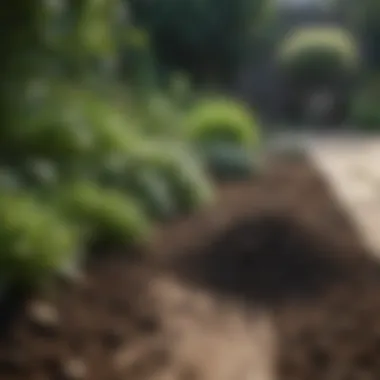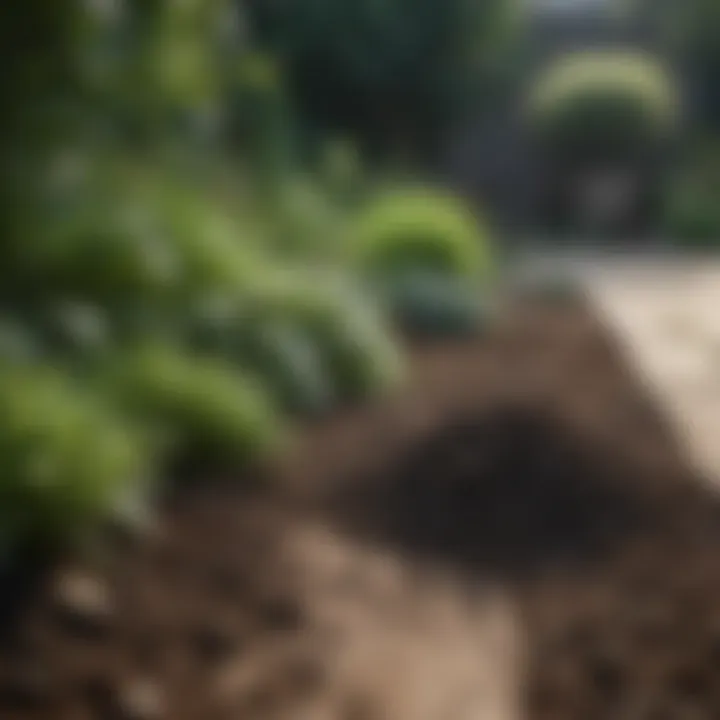Fertilizing Your Yard: A Comprehensive Guide


Intro
Fertilizing a yard is a crucial aspect of maintaining a healthy and beautiful outdoor space. Many homeowners might not realize how significant the role of proper fertilization is, not just for aesthetics but also for the overall health of their lawns and gardens. This guide aims to clarify the processes and methods employed in fertilizing yards, diving into different types of fertilizers, application techniques, and best practices. Understanding these elements can lead to a more vibrant and resilient yard.
In this exploration, we will address misconceptions that often plague homeowners regarding fertilization. For instance, the idea that all fertilizers are the same can lead to ineffective results. Instead, choosing the right fertilizer based on the soil condition, grass type, and season will make all the difference in achieving lush growth.
Additionally, the environmental impact of fertilization cannot be overlooked. By exploring organic fertilizers as alternatives, we will provide insights into sustainable practices that contribute not only to yard health but also to the ecosystem. Through this comprehensive guide, readers are invited to enhance their knowledge and skills in effectively fertilizing their yards, ultimately leading to more flourishing outdoor spaces.
Understanding Fertilizers
Types of Fertilizers
Fertilizers come in different forms, each with its own set of nutrients and application methods. Here are the primary types:
- Synthetic Fertilizers: Typically manufactured, these fertilizers provide nutrients quickly to plants. They deliver essential elements like nitrogen, phosphorus, and potassium in concentrated forms.
- Organic Fertilizers: Derived from natural sources, these include compost, manure, and plant-based products. They release nutrients slowly and improve soil structure over time.
- Slow-release Fertilizers: These are designed to release nutrients gradually, providing a steady supply for plants and reducing the risk of over-fertilization.
Timing for Application
The effectiveness of fertilization also depends on when it is applied. Factors include:
- Season: Early spring and fall are generally the best times for applying fertilizer, as these align with the natural growth cycles of most grass types.
- Soil Temperature: For optimal absorption, fertilizers should be applied when soil temperatures are conducive to growth, generally around 55–60°F.
“Applying fertilizer at the right time not only enhances nutrient uptake but also reduces waste and runoff.”
Application Techniques
Proper application methods are essential to ensure that fertilizers reach the intended areas effectively. Common techniques include:
- Broadcast Spreading: This method involves scattering fertilizer evenly over the yard. It can be done by hand or using a spreader.
- Liquid Application: Mixing fertilizer with water allows for targeted applications, especially for smaller areas or gardens.
- Soil Incorporation: This technique involves mixing granulated fertilizers into the soil before planting, ensuring that roots access nutrients right away.
Each method has its own pros and cons depending on the yard's size and the type of fertilization needed. Understanding these methods leads to better results and satisfaction with the yard's appearance.
Common Challenges
Homeowners often face challenges when fertilizing their yards. These include:
- Over-fertilization: Applying too much fertilizer can cause harm, leading to burnt grass and nutrient runoff.
- Seasonal Changes: Weather can impact the effectiveness of fertilizers. Rain may wash away nutrients, while prolonged drought can hinder absorption.
- Misunderstanding Nutritional Needs: Not all plants require the same nutrients, leading to imbalances if the wrong type of fertilizer is used.
By addressing these common issues, homeowners can optimize their fertilization efforts and promote greater yard health.
Finale
Fertilizing your yard is a disciplined process that requires thoughtful consideration and knowledge. By understanding different fertilizer types, knowing when to apply them, and utilizing proper techniques, homeowners can achieve a vibrant outdoor space. Ultimately, this guide seeks to empower you with the information needed to cultivate not just a yard, but a rightful sanctuary of rich greenery and health.
Understanding Yard Fertilization
Yard fertilization is a critical aspect of maintaining a healthy and vibrant lawn. In this section, we will explore the importance of fertilization and the basic nutritional needs of plants. Understanding how to properly fertilize your yard can lead to significant improvements in the overall health and appearance of your outdoor space. Fertilization not only provides essential nutrients that support growth but also helps to enhance the resilience of your plants against diseases and pests.
The Importance of Fertilization
Fertilization serves multiple key roles in yard maintenance. It replenishes nutrients in the soil, promoting better growth in grass, flowers, and shrubs. Without adequate fertilization, your yard may become susceptible to nutrient deficiencies, leading to stunted growth and discolored leaves. Moreover, well-fertilized lawns tend to be more robust and require less water, making them more sustainable in the long run.
Effective fertilization can also improve soil structure and enhance microbial activity, contributing further to a healthy ecosystem within your yard. Homeowners who understand the benefits of fertilization are not only better equipped to enhance the aesthetics of their lawns but also contribute to a healthier environment.
Basic Plant Nutritional Needs
Plants need various nutrients to thrive, which are classified into three categories: primary macronutrients, secondary nutrients, and micronutrients. Comprehending these needs will help you design a more effective fertilization plan tailored to your yard's specific requirements.
Primary macronutrients
Primary macronutrients, which include nitrogen, phosphorus, and potassium, are essential for plant growth and development. Nitrogen is particularly crucial as it promotes lush, green foliage. Phosphorus supports root development and flowering, while potassium aids in overall plant health and disease resistance. These nutrients are commonly found in many fertilizers due to their significant impact on plant vitality. However, excessive application can lead to nutrient runoff and environmental concerns, making their controlled use vital for responsible gardening practices.
Secondary nutrients
Secondary nutrients, such as calcium, magnesium, and sulfur, are also important for plant health but in smaller amounts compared to primary macronutrients. Calcium strengthens plant cell walls, while magnesium is vital for chlorophyll production, playing a role in photosynthesis. Sulfur contributes to protein synthesis and helps in the creation of certain vitamins. While often overlooked, these nutrients can substantially affect the overall health of your yard, and understanding their role enhances proper fertilization practices.
Micronutrients and their role


Micronutrients, including iron, manganese, and boron, are needed in even smaller quantities but are no less important. Each micronutrient serves specific functions; for example, iron is vital for chlorophyll synthesis, which plays a significant role in photosynthesis. Micronutrient deficiencies can result in various plant health issues, making it essential to ensure adequate availability through balanced fertilization. Although they are often included in general fertilizers, specific needs may arise in certain conditions that warrant further attention.
Understanding these fundamental aspects of plant nutritional needs equips you with the knowledge to make informed decisions about fertilizing your yard. By addressing these needs, homeowners can cultivate a lush, thriving lawn that is both beautiful and healthy.
Proper fertilization practices contribute significantly to the vitality and sustainability of your yard. Knowing which nutrients are necessary allows for tailored and effective application.
Types of Fertilizers
Understanding the variety of fertilizers available is crucial for effectively managing yard health. Fertilizers not only provide essential nutrients but also influence soil fertility and plant growth patterns. Knowing the differences between types can aid in making informed decisions that align with the specific requirements of your yard.
Chemical vs. Organic Fertilizers
Chemical fertilizers are synthesized from readily available minerals and nutrients. They often offer immediate results, making them appealing for quick fixes. However, overuse can lead to soil degradation and environmental harm due to runoff. On the other hand, organic fertilizers derive from natural sources such as plant or animal matter. They release nutrients gradually, promoting a healthier soil ecosystem and contributing to long-term plant vitality. While organic options may require more time to show results, they are usually safer for the environment, reducing potential harm to local ecosystems.
Common Fertilizer Formulations
Granular fertilizers
Granular fertilizers are solid, often resembling small pellets or granules. They have a slow release rate, providing a steady supply of nutrients over time. This characteristic makes them popular for homeowners looking for a low-maintenance option. However, their slower nutrient release may not meet the immediate needs of a struggling lawn.
Liquid fertilizers
Liquid fertilizers come in a solution form, allowing for quicker absorption by plants. They are particularly useful for targeting nutrient deficiencies swiftly. Their application is often easier and can be adjusted more precisely based on lawn needs. Yet, they require more frequent applications compared to granular options, leading to higher labor and potentially higher costs.
Slow-release fertilizers
Slow-release fertilizers consist of specially formulated compounds that release nutrients gradually. This method mirrors the natural nutrient release in soil and minimizes the risk of nutrient leaching. Their extended effectiveness makes them a wise choice for prolonged lawn health. Nonetheless, they can be pricier upfront, which may deter some homeowners.
Specialized Fertilizers
Starter fertilizers
Starter fertilizers are designed for newly planted grass or turf. They contain a higher ratio of phosphorus, essential for root development. By enhancing early growth, they make it easier for plants to establish themselves in their new environment. This type of fertilizer is especially beneficial for homeowners installing new lawns.
Nitrogen boosters
Nitrogen boosters are high-nitrogen fertilizers aimed at stimulating leaf growth and overall plant vigor. They are beneficial during the growing season, especially for lawns that appear yellow or lack lushness. However, reliance on nitrogen boosters can lead to problems, such as excessive growth and increased mowing frequency.
Fertilizers for specific grass types
Targeted fertilizers cater to specific grass varieties. These formulations contain nutrient combinations tailored to the growth needs of particular species, such as Kentucky bluegrass, Bermuda grass, or fescue. While using fertilizers designed for specific grass can improve lawn performance, homeowners must ensure they select the right type for their grass to avoid nutrient imbalances.
When to Fertilize Your Yard
Timing is crucial when it comes to fertilizing your yard. It can directly influence the health and appearance of your grass and plants. Knowing when to apply fertilizer involves consideration of seasonal patterns, soil temperature, and the signs indicating that your yard requires additional nutrients. This section will delve into each of these factors to provide a solid understanding of the best timing for fertilization.
Seasonal Considerations
Different seasons bring varying weather conditions that impact plant growth. Spring is usually a popular time for fertilization. The combination of warming temperatures and longer daylight hours encourages vibrant growth. Fertilization at this time can provide the nutrients essential for a strong start in the growing season.
During summer, plants often face stress due to heat. Depending on hydration and growth patterns, they may need supplemental nutrients. Applying slow-release fertilizers in summer can sustain them through these tougher months.
In autumn, many people overlook fertilization as they prepare their yards for dormancy. However, applying a fertilizer rich in potassium can strengthen root systems, making plants more hardy against winter stress.
Soil Temperature and Fertilization Timing
Soil temperature plays a critical role in nutrient uptake. The general guideline suggests that ground temperatures should reach around 55°F (13°C) before applying fertilizers for cool-season grasses. For warm-season grasses, a soil temperature of about 65°F (18°C) is ideal.
Using a soil thermometer can help in accurately gauging these temperatures. Fertilizing too early or too late may inhibit roots from absorbing the nutrients. Consequently, proper timing based on temperature ensures the maximum benefit of the fertilizer application.
Signs Your Yard Needs Fertilization
It's not always obvious when a lawn requires fertilization. However, certain signs can help homeowners understand when to act.
Color changes
Color changes in grass are often one of the first indicators that fertilizers may be needed. A lawn that has turned from a lush green to shades of yellow or light green might indicate nutrient deficiency, particularly nitrogen. This specific characteristic is notable as it signals an immediate need for intervention. Failing to respond to these color changes may lead to further deficiencies and stunted growth.


Growth patterns
Observation of growth patterns is another way to assess yard health. Grass that grows unevenly, or seems to be stunted, can be a sign that it needs fertilization. Such growth patterns are clearly a critical aspect because they reflect the overall shaping of your yard. If certain areas look lush while others appear bare, it shows that nutrient distribution is inconsistent. Correspondingly, fertilizing those less robust areas can encourage uniform growth throughout the entire lawn.
Disease susceptibility
A yard’s susceptibility to diseases can also indicate a need for fertilization. Healthy plants are more resilient to diseases. For example, if patches of grass are easily affected by fungal infections, it could signal nutritional weaknesses. Addressing this issue through proper fertilization can bolster a lawn's defenses against pests and diseases, thereby enhancing its overall longevity.
Proper timing and application of fertilizer play a vital role in maintaining a vibrant yard.
In summary, understanding when to fertilize your yard—taking seasonal factors, soil temperatures, and clear signs of nutritional needs into account—ensures your lawn remains healthy and vibrant. By closely monitoring these elements, you can make informed decisions on fertilization timing, ultimately supporting the lushness and resilience of your outdoor space.
Effective Application Techniques
Applying fertilizer effectively is crucial for maximizing the health and aesthetics of your yard. It influences how well your plants absorb nutrients, and thus affects their growth and appearance. Without proper application techniques, even the best fertilizers can yield suboptimal results. There are various elements to consider, including the right amount to use, methods of application, and best practices to follow. This section will explore each of these aspects in detail.
Calculating the Right Amount
Understanding product labels
Understanding product labels is essential when selecting a fertilizer. These labels provide important information about the nutrient content and application instructions. Each fertilizer product has a unique formula, indicated by the three numbers on the label, representing nitrogen, phosphorus, and potassium (N-P-K). For instance, a label that reads 10-10-10 indicates an equal balance of these nutrients, while a 20-10-10 formula indicates a higher nitrogen content.
Knowing how to interpret these numbers helps in choosing a product that meets the specific needs of your yard. It is a beneficial practice as it guides you toward the correct choice based on what your plants require. However, following the recommended amounts is crucial. Using too much can lead to nutrient burn, harming your plants and potentially polluting local water sources.
Using soil tests for guidance
Using soil tests for guidance helps determine the nutrient levels in your yard. These tests can reveal deficiencies or excesses in certain nutrients, allowing for targeted fertilization. A soil test kit is usually easy to use and available at garden centers or through local agricultural extensions. The results provide detailed insights into pH levels and nutrient availability.
This method is especially valuable as it tailors your fertilization strategy to the specific conditions of your soil. However, soil tests can take time and may require patience before results are available for use. Balancing the time it takes to receive results with the immediate needs of your lawn is an important consideration.
Methods of Application
Broadcasting
Broadcasting is a technique where fertilizer is spread evenly across the lawn surface. This method is straightforward and popular among homeowners. It works well for larger areas, as it allows for quick application over vast spaces. Additionally, it is simple to carry out with a spreader, ensuring uniform distribution.
However, one drawback is that it can lead to uneven coverage if not done carefully, resulting in patchy growth. It might also result in runoff during heavy rains, losing some of the fertilizer’s effectiveness.
Sidedressing
Sidedressing involves applying fertilizer alongside existing plants, often targeting the root zone. This method is useful for established gardens and landscapes, especially for heavy feeders like vegetables. Its primary benefit is that it provides a direct nutrient boost to the plants that require it most.
This technique can be labor-intensive, as it often requires manual application. While it is effective, timing is crucial to ensure the nutrients are available when the plants need them.
Foliar feeding
Foliar feeding is the application of liquid fertilizer directly to the leaves of plants. This method allows for rapid absorption of nutrients, which can be beneficial during periods of stress. It is an excellent choice for addressing micronutrient deficiencies quickly.
However, it requires careful mixing and application. Too much fertilizer can cause leaf burn, making precise measurement necessary. Additionally, foliar feeding is generally not a substitute for soil fertilization, as it does not address all nutrient needs.
Best Practices for Fertilizing
Watering after application
Watering after application is a crucial step to activate the fertilizer in the soil. It helps dissolve the nutrients, allowing them to penetrate into the soil and reach plant roots effectively. It also helps prevent fertilizer granules from sitting on the surface, which can lead to burn.
This practice enhances nutrient uptake and promotes healthier growth. However, overwatering can lead to runoff or leaching, so finding the right balance is essential.
Avoiding over-fertilization
Avoiding over-fertilization is vital for maintaining a healthy yard. Excess fertilizer can harm plants and lead to environmental issues, such as water pollution. Fertilizer burn can cause browning or wilting, which is detrimental to the overall health of the garden.
By following label instructions and conducting soil tests, homeowners can prevent over-fertilization. This measure is a best practice that not only preserves plant health but also supports local ecosystems.
Applying during optimal weather conditions
Applying fertilizer during optimal weather conditions can significantly affect the results. Ideally, fertilization should occur when there is no heavy rain in the forecast. Rain can wash away nutrients before they have a chance to be absorbed.


Additionally, applying on dry days with slight humidity can increase efficiency. Temperature should also be moderate, as extreme heat might hinder nutrient uptake. This careful timing enhances efficacy and promotes a thriving yard.
Effective application techniques ensure that your efforts yield the finest results, supporting a robust and lush landscape.
Challenges and Misconceptions
Fertilization can often be surrounded by a cloud of confusion, leading to misconceptions that can adversely affect lawn health. Addressing these challenges is crucial for homeowners and gardening enthusiasts. Misunderstandings about fertilization can lead to ineffective practices or even harm the environment. It is imperative to clarify these common myths while also examining the environmental repercussions of fertilizer use.
Common Misunderstandings about Fertilization
Many people believe that more fertilizer leads to a greener lawn. This misunderstanding can lead to over-fertilization, which can cause nutrient burn and kill grass rather than promoting its growth. Another common myth is that all fertilizers are the same. This fails to recognize the differences between chemical and organic options and their respective impacts on the soil and plants. Understanding these fundamental misconceptions can help in adjusting practices for better results.
Environmental Considerations
The impact of fertilizers extends beyond the lawn itself. Recognizing this influence is essential for sustainable gardening practices.
Fertilizer runoff
Fertilizer runoff occurs when rain or irrigation causes fertilizers to wash off lawns into nearby waterways. This unwanted movement can lead to eutrophication, creating conditions that diminish water quality. Key characteristics of fertilizer runoff include nutrient enrichment of water bodies, which can result in excessive algae growth.
Runoff can be problematic and its consequences severe. Therefore, applying the right amount of fertilizer at the right time can mitigate this issue. This article emphasizes the importance of responsible application practices. Always adhere to recommended guidelines on product labels.
Impact on local ecosystems
Fertilizers can significantly influence local ecosystems. When runoff enters streams or lakes, it affects aquatic life. Elevated nutrient levels can create toxic environments for fish and other wildlife. The unique feature of this impact is the interconnectedness of ecosystems; what happens on land can directly affect waterways and habitats.
Long-term use of synthetic fertilizers often leads to soil degradation, reducing its natural fertility. Thus, stewardship practices, such as planting cover crops or applying organic matter, help sustain local ecosystems. Homeowners can adopt practices that minimize their ecological footprint while maintaining healthy, vibrant lawns.
Exploring Organic Alternatives
In the quest for a healthier yard, exploring organic alternatives becomes essential. Organic fertilizers offer a sustainable way to enhance soil health and, consequently, the vitality of plants. These options are derived from natural sources, promoting not only plant growth but also environmental stewardship. Homeowners often find that organic fertilizers work slowly but effectively over time, leading to improved soil structure and microorganism activity.
Benefits of Organic Fertilizers
Organic fertilizers provide multiple benefits. Firstly, they enrich the soil with essential nutrients, often resulting in increased water retention and aeration. This is crucial for deep root development and overall plant health. Moreover, organic options reduce the risk of nutrient leaching, offering a more stable nutrient release for plants. They also minimize chemical exposure, being less harsh on the environment. These fertilizers can enhance microbial life in the soil, fostering a rich ecosystem that supports plant growth.
Homemade Fertilizer Options
Homemade fertilizers are becoming more popular among gardeners seeking sustainable practices. They allow for customization based on specific yard needs and can also make better use of waste materials.
Composting
Composting stands out as a vital method of recycling organic matter. Composting transforms kitchen scraps, yard waste, and other biodegradable materials into nutrient-rich compost. This process not only reduces waste but also creates a natural fertilizer that improves soil structure. A key characteristic of composting is its ability to feed soil microbes, essential for soil health. The unique feature of composting is how it harnesses local resources, making it an economical choice. The main disadvantage is the time required for compost to mature; however, the long-term benefits often outweigh this drawback.
Using Kitchen Waste
Using kitchen waste effectively contributes to fertilization through direct recycling. Items like vegetable peelings, coffee grounds, and eggshells can provide essential nutrients. The key characteristic of using kitchen waste is accessibility; most households generate this waste regularly. This practice leverages everyday materials, making it an environmentally friendly option. A notable downside is the need to balance nitrogen and carbon sources to ensure optimal decomposition, but the rewards can lead to a fruitful garden.
Benefits of Organic Amendments
Incorporating organic amendments such as manures, bone meal, and green manure enhances nutrient availability in the soil. These amendments contribute to overall soil health, supporting disease resistance and drought resilience. The beneficial aspect of organic amendments lies in their capability to improve soil fertility and structure. An advantage is their slow nutrient release capacity, allowing for sustained plant growth over time, although sourcing high-quality amendments can be challenging.
Organic alternatives not only enrich your soil but also promote a healthier gardening ecosystem.
Culmination and Future Considerations
Fertilizing your yard is not just a seasonal chore; it is a vital part of maintaining a healthy and flourishing outdoor space. As we conclude this guide, it becomes essential to understand the long-term implications of proper fertilization practices. Homeowners and gardeners must consider various factors to ensure their yards remain vibrant and sustainable over time.
A critical aspect of maintaining a healthy yard long-term involves ongoing soil health. By regularly assessing the nutrient levels in your soil, you can tailor your fertilization approach to meet the specific needs of your yard. Soil testing allows you to determine the right balance of nutrients, thus avoiding deficiencies or excesses that can harm plant health.
Another important consideration is the cultivation of healthy lawn habits. Routine care, including proper watering and mowing practices, can enhance the effectiveness of fertilization efforts. Ensuring that your lawn is not overwatered or cut too short can create an environment supportive of nutrient uptake.
Maintaining a Healthy Yard Long-Term
To sustain a healthy yard, consider these key principles:
- Regular Soil Testing: Soil tests should be performed every few years to gauge pH levels and nutrient content. Adjust fertilization based on test results.
- Use the Right Fertilizer: Match your fertilizer selection to plant type and stage of growth. Organic options can be particularly beneficial for long-term health.
- Focus on Sustainable Practices: Implementing sustainable methods, like composting or using crop rotation, ensures your yard becomes resilient against pests and diseases.
- Avoid Chemical Overload: Over-fertilization can lead to nutrient leaching and water pollution. It is crucial to follow guidelines and apply only necessary amounts.
By integrating these principles, you can create a thriving yard that not only looks good but is also environmentally responsible.
"Maintaining a healthy yard is a year-round commitment that requires thoughtful planning and execution."
In summary, fertilizing your yard effectively is a blend of science and art. Understanding the specific needs of your plants, applying the right fertilizers at the right times, and adopting sustainable practices will go a long way in ensuring that your yard remains lush and resilient in future seasons.



